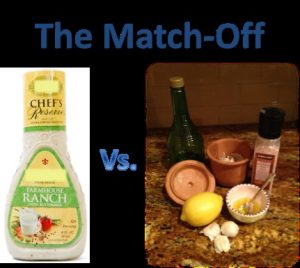The trade-in: Bottled dressing for homemade dressing (plus tricks when eating out).

Where does your dressing stack up? Most don’t. The majority are loaded with calories, unhealthy sodium, fats, cholesterol, and even sugar. Your dressing is probably sabotaging your good intentions. Even the low-fat dressings can have up to 21% of your recommended daily sodium intake plus added sugars.
The marriage of such a healthy plate combined with an explosion of health disrupting ingredients is tragic. This marriage didn’t start out this way and there’s a way to reconcile it.
Health Danger #1: High Sodium: Let’s review some random bottled dressings versus your own healthful dressings you can make at home:
| Salad Dressings Compared | ||||||
| Dressing Type | Calories | Sodium mg | Sodium | Sugar | Fat | Sat Fat |
| Ken’s Steak House Creamy Parmesan | 180 | 360 | 12.5% | 0 | 28% | 15% |
| Herbal Kitchen Vinaigrette | 12 | 0 | 0 | 2% | 19% | 5% |
| Hidden Valley Ranch | 140 | 250 | 10.8% | 0 | 22% | 12.5% |
| Wishbone Italian | 90 | 490 | 20.5% | 3% | 12% | 5% |
| Cain’s Italian Fat Free | 15 | 500 | 20.8% | 4% | 0 | 0 |
| Homemade Vinegar and Oil | 75 | 75 | 3% | 0 | 12% | 4% |
| Homemade Olive Oil and Lemon | 125 | 92 | 3.8% | 0 | 16.8% | 3.6% |
Some of the most popular dressings are loaded with salt, up to 500 mg representing over 20% of your recommended daily allowance and over 600% more than a homemade dressing. Sodium excess can inhibit the absorption of nutrients and disrupt body functions. While sodium is needed in our diet, The American Heart Association states that 9 out of 10 Americans consume too much, over 3,600 mg. The average recommended sodium is only 1,500 mg. Sodium excess can lead to high blood pressure, stroke, heart failure, kidney stones, stomach cancer, headaches, weight gain and puffiness, just to name a few.
Calorielab is a good source to review your current salad dressing is at: http://calorielab.com/brands/salad-dressing/132
Not All Salt is Equal. If you read the Trade-in on Table Salt vs. Himalayan Salt, you already know that you can begin to trade-out your current salt with a healthy salt loaded with essential minerals for your body. By making your own salad dressing, you can begin to also lower your salt intake.
Not All Fat is Equal. By using extra virgin olive oil, you can also replace unhealthy fats with healthy ones, while controlling your overall fat intake: a better step for your health.
Adding Good Calories. With the many easy and healthy recipes you can lower your caloric intake while increasing the nutritional value.
Simple Recommendations for Home and Away:
1). Aim to have a salad at lunch and at dinner.
2). When ordering a restaurant salad:
– Ask for the dressing on the side. You can control the amount of dressing that you apply. Use a bit less. A good salad doesn’t have to be drenched in dressing, the dressing should simply complement it.
– Order a vinegar and oil, olive and lemon, or other light dressing to reduce the calories and sodium.
3). Salads prepared at home:
– Use a glass jar, a jelly jar, or salad dressing bottle and prepare a dressing for the week. Just store it in the refrigerator. It takes less than 8 minutes and tastes much better than any bottled dressings. Once a week rinse it out, throw it in the dishwasher or clean it, and make a new one. The benefits include:
- Flavorful and tasty vs. heavy and preserved
- Simple to prepare and worth the 8-minute effort
- Inexpensive as compared to buying from the store
- Can boost the nutritional benefits
- Reduce your sodium and fat intake to benefit your health, weight, and how you feel.
– Bring a salad to work and put your dressing in a small Tupperware container if possible.
Get started and see how easy it is. Once you make it on your first week, you’ll be hooked. Fresh always tastes better than preserved, bottled goods. Keep some of our tasty recipes below to change things up. Also, refer to the recipes in the IQYOU foods area.
Your waistline will thank you, your cells will thank you, your wallet will be relieved, and you’ll feel better. You’re simply substituting one choice for a better one for your best health.
Recipe #1: Lemon and Oil
Benefits:
Lemons contain unique flavonoid compounds that have antioxidant properties, including vitamin C. A recent study suggests that high doses of supplemental vitamin C provide us with protection against inflammatory polyarthritis, a form of rheumatoid arthritis involving two or more joints. Olive oil is an anti-inflammatory and is a healthy monounsaturated fat (as opposed to saturated fats and trans fats). It can lower your LDL (bad cholesterol) and is believed to lower the risk of heart disease, high blood pressure, and stroke.
Ingredients:
- 1 tbsp. fresh lemon juice (1 squeezed lemon)
- 2 – 3 tbsp. extra virgin olive oil
- 1 small clove garlic, minced (optional)
- 1/2 tsp. finely grated lemon zest (optional)
- 1/2 tsp. Himalayan salt
- A dash of freshly-ground black pepper
- 1/4 tsp. dry mustard or Dijon mustard
Preparation:
Put ingredients in a glass jar and shake to blend. Adjust salt to taste. If the taste is too citric for you, add more olive oil. It’s ready to use. May store in refrigerator chilled for up to a week (It will solidify in the refrigerator, just shake it or leave out on the counter for a few minutes, then shake). Enough for a large salad. Double the ingredients to make enough for the week.
Recipe #2: Vinegar and Oil: A classic French vinaigrette is typically 3 to 4 parts oil (usually extra virgin olive oil) and 1 part red wine vinegar. Ase the same seasonings from above: salt, pepper (freshly ground) and/or Dijon mustard.
Other Recipes:
Recipe #3: Healthy Caesar: http://whfoods.org/genpage.php?tname=recipe&dbid=23
Recipe #4: Cucumber Salad: http://whfoods.org/genpage.php?tname=recipe&dbid=64






Leave a Reply